Impact of Integrated Rice-Crayfish Farming on Soil Aggregates and Organic Matter Distribution
Abstract
:1. Introduction
2. Materials and Methods
2.1. Overview of The Research Area
2.2. Sample Setup and Collection
2.3. Experimental Methods
2.3.1. Determination of Soil Aggregate Structure
2.3.2. Determination of Soil Organic Matter
2.3.3. Calculation of Effective Value and Contribution of Soil Organic Matter
2.4. Methods of Statistical Analysis
3. Results
3.1. Structural Analysis of Soil Aggregates
3.2. Stability Analysis of Soil Aggregates
3.3. Soil Aggregate Structure and Soil Organic Matter Analysis
4. Discussion
4.1. Distribution of Soil Aggregates
4.2. Stability of Soil Aggregates
4.3. Organic Matter in Soil Aggregates by Particle Size
4.4. Research Shortcomings and Future Prospects
5. Conclusions
Author Contributions
Funding
Data Availability Statement
Conflicts of Interest
References
- Rojas, R.V.; Achouri, M.; Maroulis, J.; Caon, L. Healthy soils: A prerequisite for sustainable food security. Environ. Earth Sci. 2016, 75, 180. [Google Scholar] [CrossRef]
- Dynarski, K.A.; Bossio, D.A.; Scow, K.M. Dynamic Stability of Soil Carbon: Reassessing the “Permanence” of Soil Carbon Sequestration. Front. Environ. Sci. 2020, 8, 514701. [Google Scholar] [CrossRef]
- Barthès, B.; Roose, E. Aggregate stability as an indicator of soil susceptibility to runoff and erosion; validation at several levels. Catena 2002, 47, 133–149. [Google Scholar] [CrossRef]
- Okolo, C.C.; Gebresamuel, G.; Zenebe, A.; Haile, M.; Eze, P.N. Accumulation of organic carbon in various soil aggregate sizes under different land use systems in a semi-arid environment. Agric. Ecosyst. Environ. 2020, 297, 106924. [Google Scholar] [CrossRef]
- Sun, Z.; Liu, Z.; Han, J.; Wang, H.; Zhang, H.; Yan, J. Long-term effects of soft rock amendment on changes of soil aggregate cementing agents of sandy soil by SEM-EDS. Front. Environ. Sci. 2023, 11, 1207781. [Google Scholar] [CrossRef]
- Bongiovanni, M.D.; Lobartini, J.C. Particulate organic matter, carbohydrate, humic acid contents in soil macro- and microaggregates as affected by cultivation. Geoderma 2006, 136, 660–665. [Google Scholar] [CrossRef]
- Pihlap, E.; Steffens, M.; Koegel-Knabner, I. Initial soil aggregate formation and stabilisation in soils developed from calcareous loess. Geoderma 2021, 385, 114854. [Google Scholar] [CrossRef]
- Zotarelli, L.; Alves, B.J.R.; Urquiaga, S.; Boddey, R.M.; Six, J. Impact of tillage and crop rotation on light fraction and intra-aggregate soil organic matter in two Oxisols. Soil Tillage Res. 2007, 95, 196–206. [Google Scholar] [CrossRef]
- Kamau, S.; Barrios, E.; Karanja, N.K.; Ayuke, F.O.; Lehmann, J. Dominant tree species and earthworms affect soil aggregation and carbon content along a soil degradation gradient in an agricultural landscape. Geoderma 2020, 359, 113983. [Google Scholar] [CrossRef]
- Liu, Y.; Liu, W.; Wu, L.; Liu, C.; Wang, L.; Chen, F.; Li, Z. Soil aggregate-associated organic carbon dynamics subjected to different types of land use: Evidence from 13C natural abundance. Ecol. Eng. 2018, 122, 295–302. [Google Scholar] [CrossRef]
- Rabbi, S.M.F.; Wilson, B.R.; Lockwood, P.V.; Daniel, H.; Young, I.M. Soil organic carbon mineralization rates in aggregates under contrasting land uses. Geoderma 2014, 216, 10–18. [Google Scholar] [CrossRef]
- Tisdall, J.M.; Cockroft, B.; Uren, N.C. The stability of soil aggregates as affected by organic materials, microbial activity and physical disruption. Aust. J. Soil Res. 1978, 16, 9–17. [Google Scholar] [CrossRef]
- Are, M.; Kaart, T.; Selge, A.; Reintam, E. The Effects of Crops Together with Winter Cover Crops on the Content of Soil Water-Stable Aggregates in Organic Farming. Agriculture 2021, 11, 1035. [Google Scholar] [CrossRef]
- Tobiášová, E.S.A.U. Land use influence on micro-aggregates. Folia Oecologica 2011, 38, 126. [Google Scholar]
- Mbagwu, J.S.C.; Bazzoffi, P. Properties of soil aggregates as influenced by tillage practices. Soil Use Manag. 2007, 5, 180–188. [Google Scholar] [CrossRef]
- Dong, X.; Guan, T.; Li, G.; Lin, Q.; Zhao, X. Long-term effects of biochar amount on the content and composition of organic matter in soil aggregates under field conditions. J. Soil Sediment 2016, 16, 1481–1497. [Google Scholar] [CrossRef]
- Fonte, S.J.; Barrios, E.; Six, J. Earthworm impacts on soil organic matter and fertilizer dynamics in tropical hillside agroecosystems of Honduras. Pedobiologia 2010, 53, 327–335. [Google Scholar] [CrossRef]
- Waters, A.G.; Oades, J.M. Organic Matter in Water-stable Aggregates. In Advances in Soil Organic Matter Research; Wilson, W.S., Ed.; Woodhead Publishing: Cambridge, UK, 2003; pp. 163–174. [Google Scholar]
- Zhang, D.; Zhang, W.; Cao, Y.; Zhu, J.; Gao, H.; Ye, X.; Hou, J. Integrative analysis of poor rice yield and influencing factors in rice-fishery aquaculture system in China. Jiangsu Agric. Sci. 2022, 50, 88–95. [Google Scholar] [CrossRef]
- Xiao, L.; Yang, H.; Lai, Z.; Lai, S.; Ni, C.; Chen, X.; Jian, M. Characteristics of soil microbial communities in paddy fields in response to rice-turtle cropping. J. Agric. Eng. 2022, 38, 102–109. [Google Scholar] [CrossRef]
- Yu, S.; Ouyang, Y.; Zhang, Q.; Peng, G.; Xu, D.; Jin, Q. Effects of a rice-duck complex system on rice growth and yield. J. Appl. Ecol. 2005, 16, 1252–1256. [Google Scholar]
- Zheng, H.B.; Hu, T.; Chen, Y.; Huang, J. Analysis of rice yield and economic benefits of rice-mallard duck composite ecological farming technology. Crop Res. 2012, 26, 127–130. [Google Scholar]
- Ni, M.L.; Deng, K.; Zhang, W.Y.; Shang, Y.Q.; Wei, F.; Yuan, P.L.; Li, Z.; Fan, D.; Cao, M.G.; Wang, J.P. Impacts of rice-shrimp aquaculture on rice yield and food security. Chin. J. Ecol. Agric. 2022, 30, 1293–1300. (In English) [Google Scholar] [CrossRef]
- Zhu, Y.; Shen, H.; Feng, Y.; Li, H.; Akinyemi, D.S.; Hu, H.; Fang, J. Effects of shrub encroachment on soil aggregates and organic carbon vary in different grasslands in Inner Mongolia, China. Ecosphere 2021, 12, e03363. [Google Scholar] [CrossRef]
- Totsche, K.U.; Amelung, W.; Gerzabek, M.H.; Guggenberger, G.; Klumpp, E.; Knief, C.; Lehndorff, E.; Mikutta, R.; Peth, S.; Prechtel, A.; et al. Microaggregates in soils. J. Plant Nutr. Soil Sci. 2018, 181, 104–136. [Google Scholar] [CrossRef]
- Hernandez, T.; Hernandez, M.C.; Garcia, C. The effects on soil aggregation and carbon fixation of different organic amendments for restoring degraded soil in semiarid areas. Eur. J. Soil Sci. 2017, 68, 941–950. [Google Scholar] [CrossRef]
- Annabi, M.; Le Bissonnais, Y.; Le Villio-Poitrenaud, M.; Houot, S. Improvement of soil aggregate stability by repeated applications of organic amendments to a cultivated silty loam soil. Agric. Ecosyst. Environ. 2011, 144, 382–389. [Google Scholar] [CrossRef]
- Teixeira, P.C.; Misra, R.K. Erosion and sediment characteristics of cultivated forest soils as affected by the mechanical stability of aggregates. Catena 1997, 30, 119–134. [Google Scholar] [CrossRef]
- Yudina, A.; Klyueva, V.; Romanenko, K.; Fomin, D. Micro- within macro: How micro-aggregation shapes the soil pore space and water-stability. Geoderma 2022, 415, 115771. [Google Scholar] [CrossRef]
- Zou, L.; Chen, F.; Duncan, D.S.; Fang, X.; Wang, H. Reforestation and slope-position effects on nitrogen, phosphorus pools, and carbon stability of various soil aggregates in a red soil hilly land of subtropical China. Can. J. For. Res. 2015, 45, 26–35. [Google Scholar] [CrossRef]
- Das, B.; Chakraborty, D.; Singh, V.; Aggarwal, P.; Singh, R.; Dwivedi, B. Effect of Organic Inputs on Strength and Stability of Soil Aggregates Under Rice-Wheat Rotation. Int. Agrophys. 2014, 28, 163–168. [Google Scholar] [CrossRef]
- Li, W.; Zheng, Z.; Li, T.; Zhang, X.; Wang, Y.; Yu, H.; He, S.; Liu, T. Effect of tea plantation age on the distribution of soil organic carbon fractions within water-stable aggregates in the hilly region of Western Sichuan, China. Catena 2015, 133, 198–205. [Google Scholar] [CrossRef]
- Ussiri, D.; Lal, R.; Jacinthe, P. Post-Reclamation Land Use Effects on Properties and Carbon Sequestration in Minesoils of Southeastern Ohio. Soil Sci. 2006, 171, 261–271. [Google Scholar] [CrossRef]
- Goh, K.; Rafter, T.; Stout, J.; Walker, T. The accumulation of soil organic matter and its carbon isotope in a chronosequence of soils developed on aeolian sand in New Zealand. J. Soil Sci. 2006, 27, 89–100. [Google Scholar] [CrossRef]
- Wei, X.; Xiong, J.; Li, T.; Wen, J.; Zeng, X.; Yu, D. Effects of different organic amendments on soil organic carbon and its labile fractions in the paddy soil of a double rice cropping system. Ying Yong Sheng Tai Xue Bao = J. Appl. Ecol. 2020, 31, 2373–2380. [Google Scholar] [CrossRef]
- Almendros, G.; Giampaolo, S.; Pardo, M. Laboratory appraisal of carbon sequestration and nutrient availability after different organic matter inputs in virgin and cultivated Zimbabwean soils. Commun. Soil Sci. Plant Anal. 2007, 32, 877–894. [Google Scholar] [CrossRef]
- Civeira, G.I.D.S. Estimation of carbon inputs to soils from wheat in the Pampas Region, Argentina. Czech J. Genet. Plant 2011, 47, S39–S42. [Google Scholar] [CrossRef]
- Phaneendra, B.; Ramamurthy, V.; Maske, S. Pedological Assessment of Soil Organic Carbon and Total Nitrogen Contents in Wetland Rice Ecosystems of Majuli River Island, Assam, India. In Soil Nitrogen Ecology; Springer International Publishing: Cham, Switzerland, 2021; pp. 93–109. [Google Scholar]
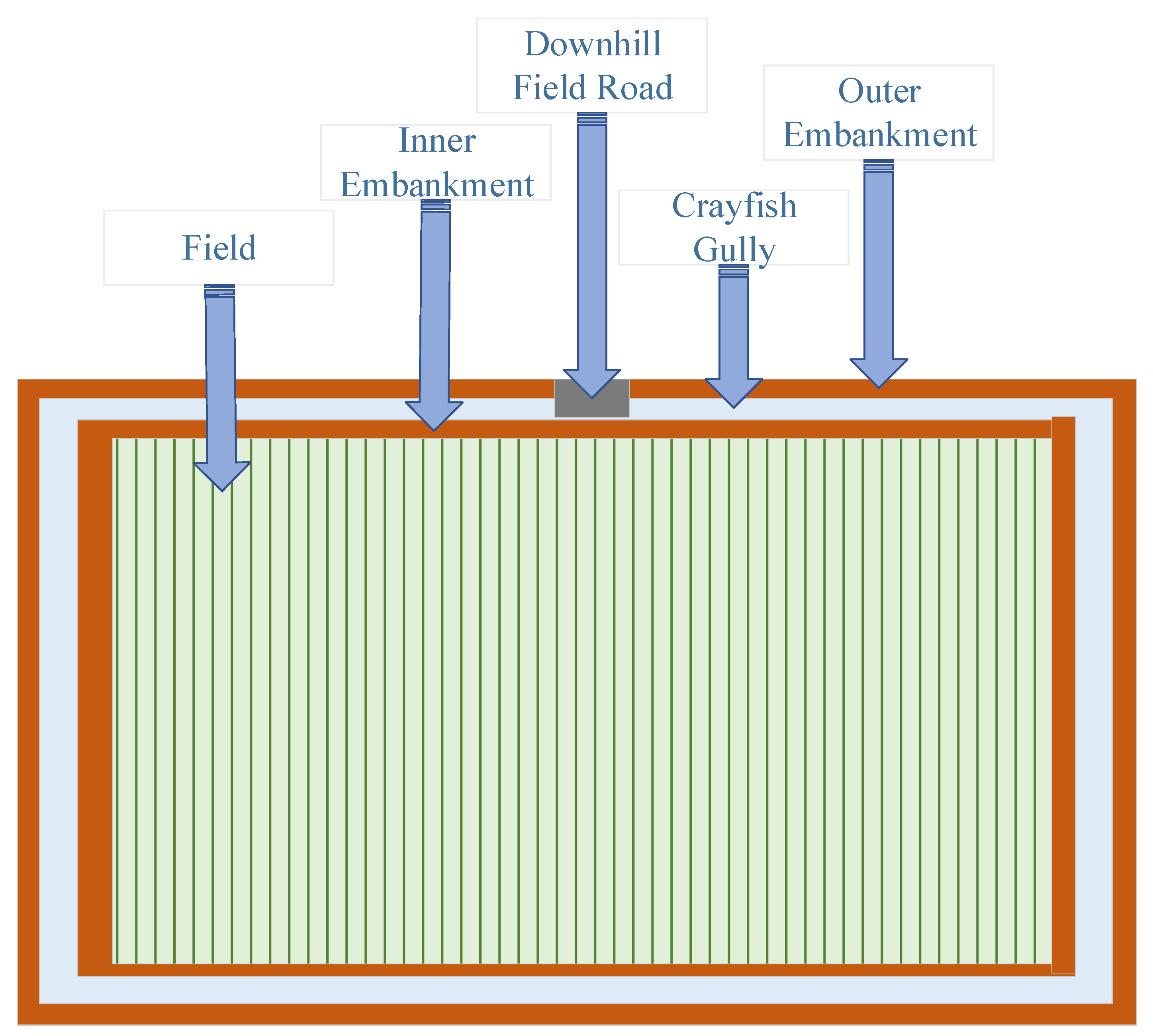

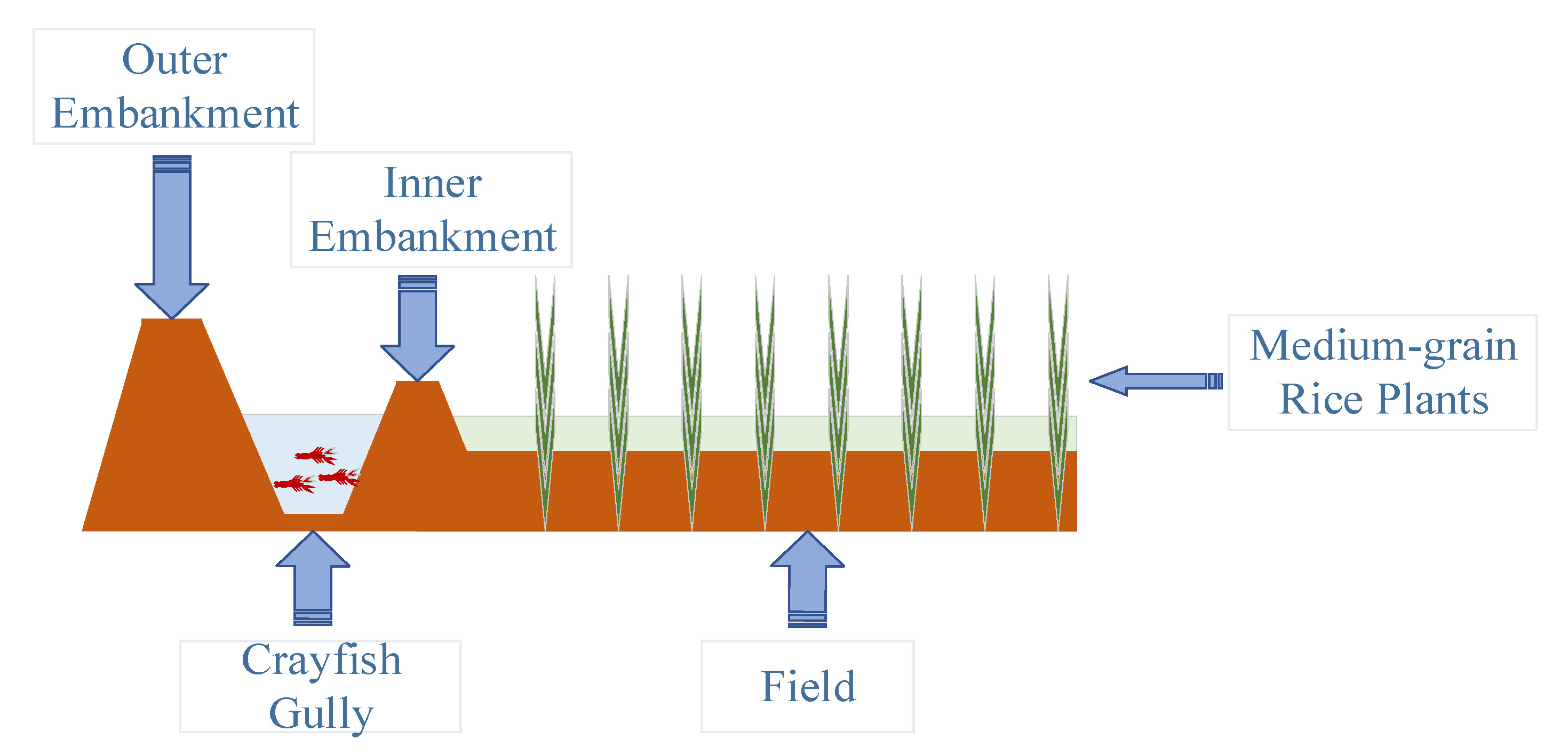
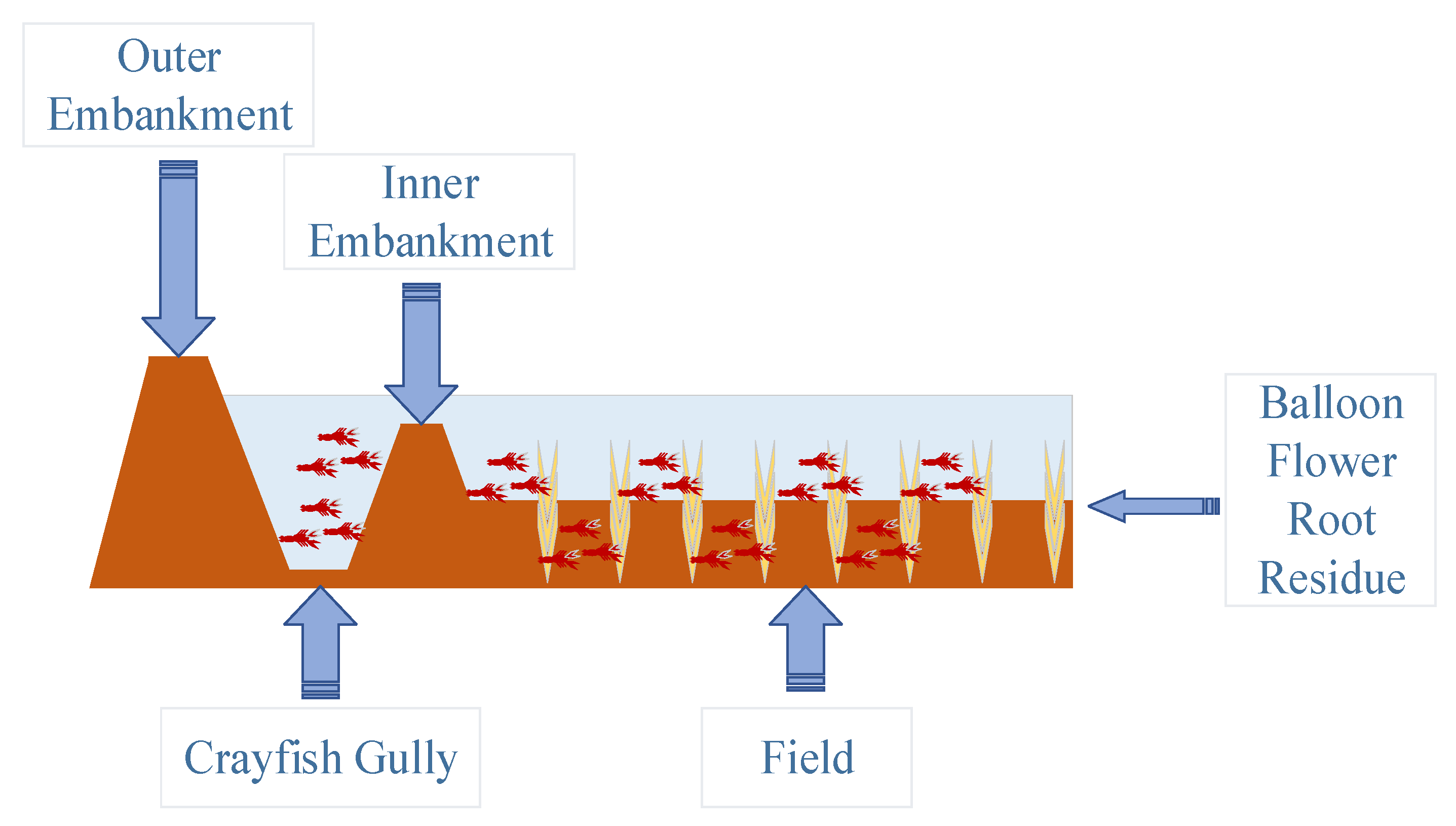
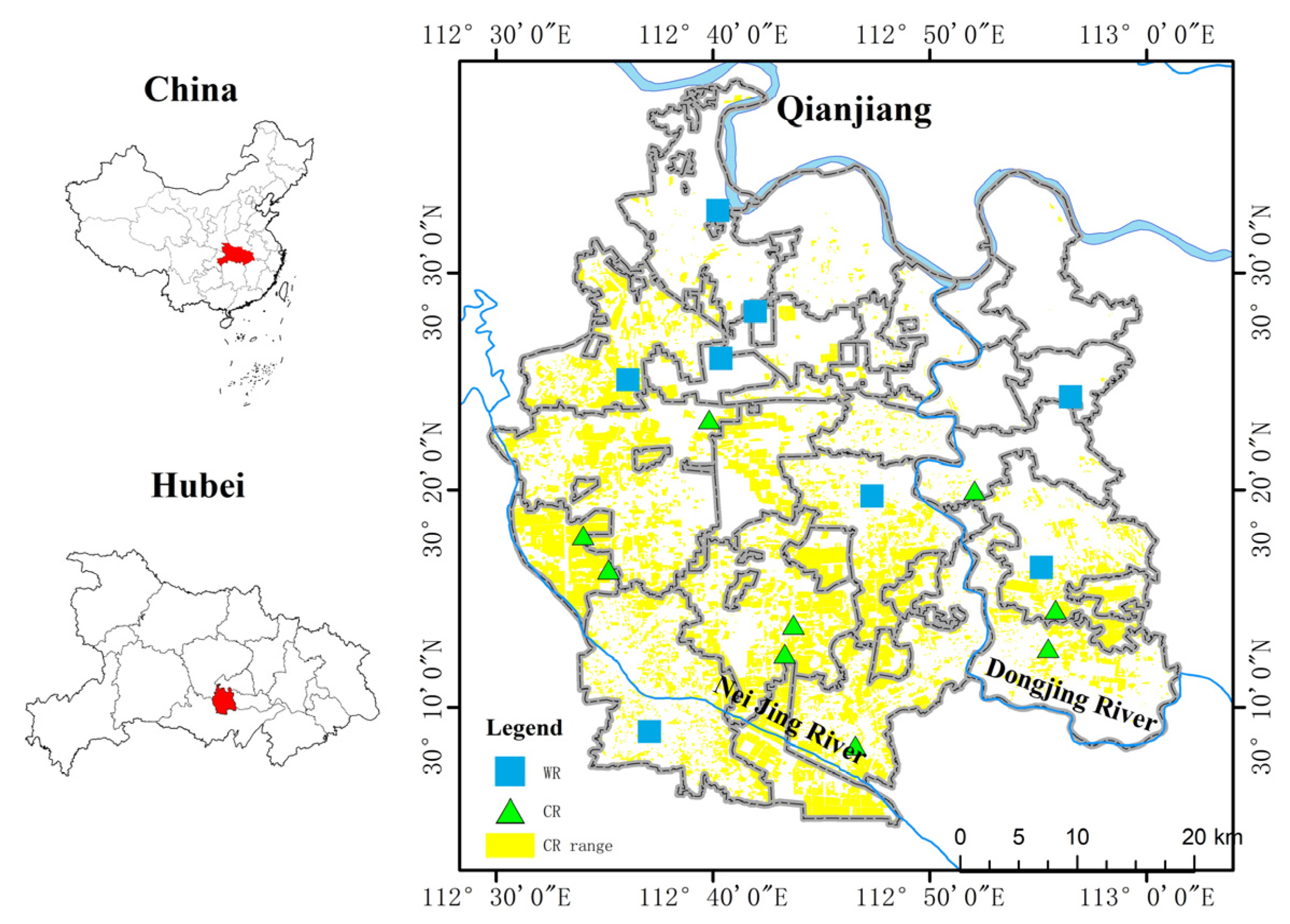
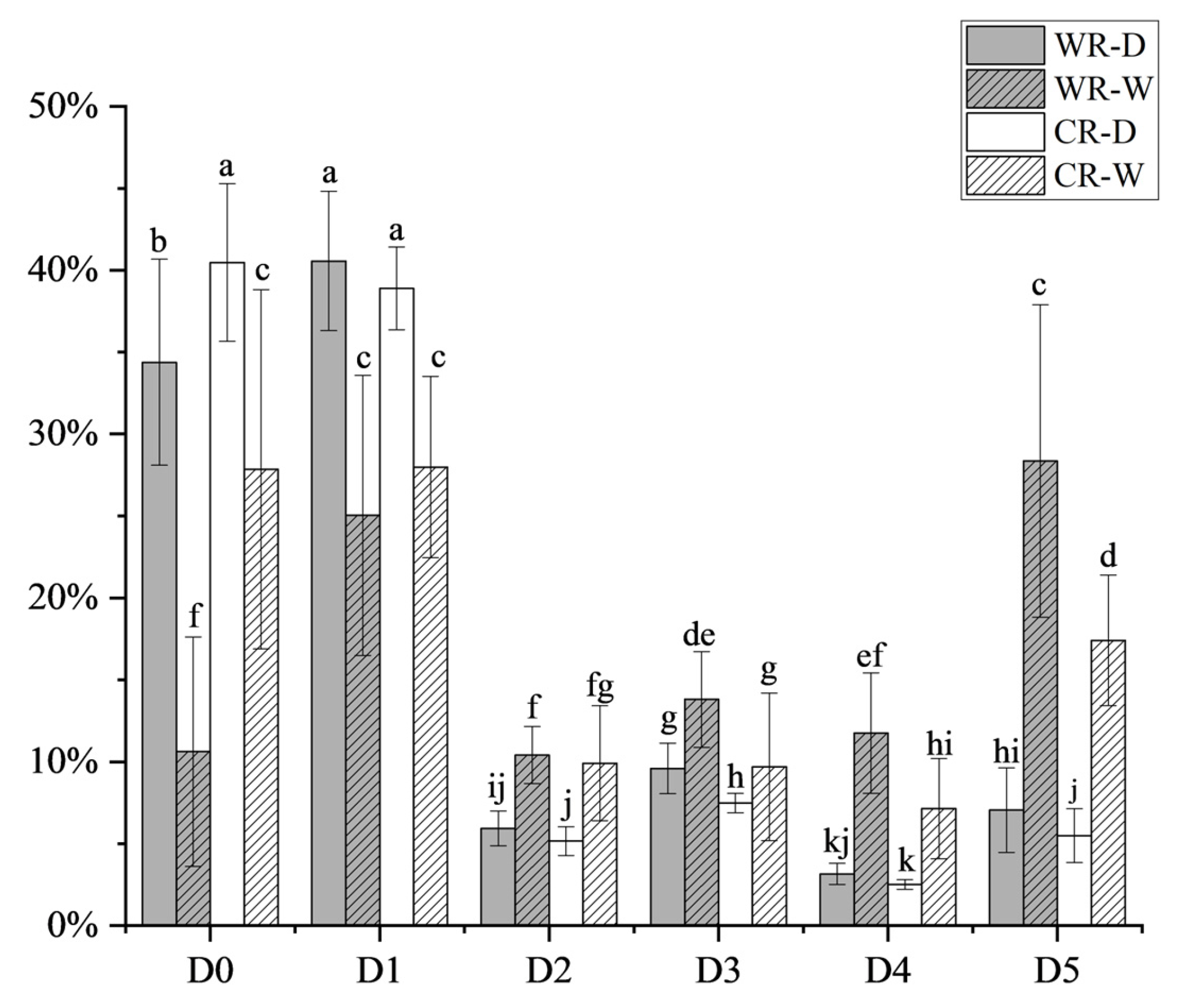
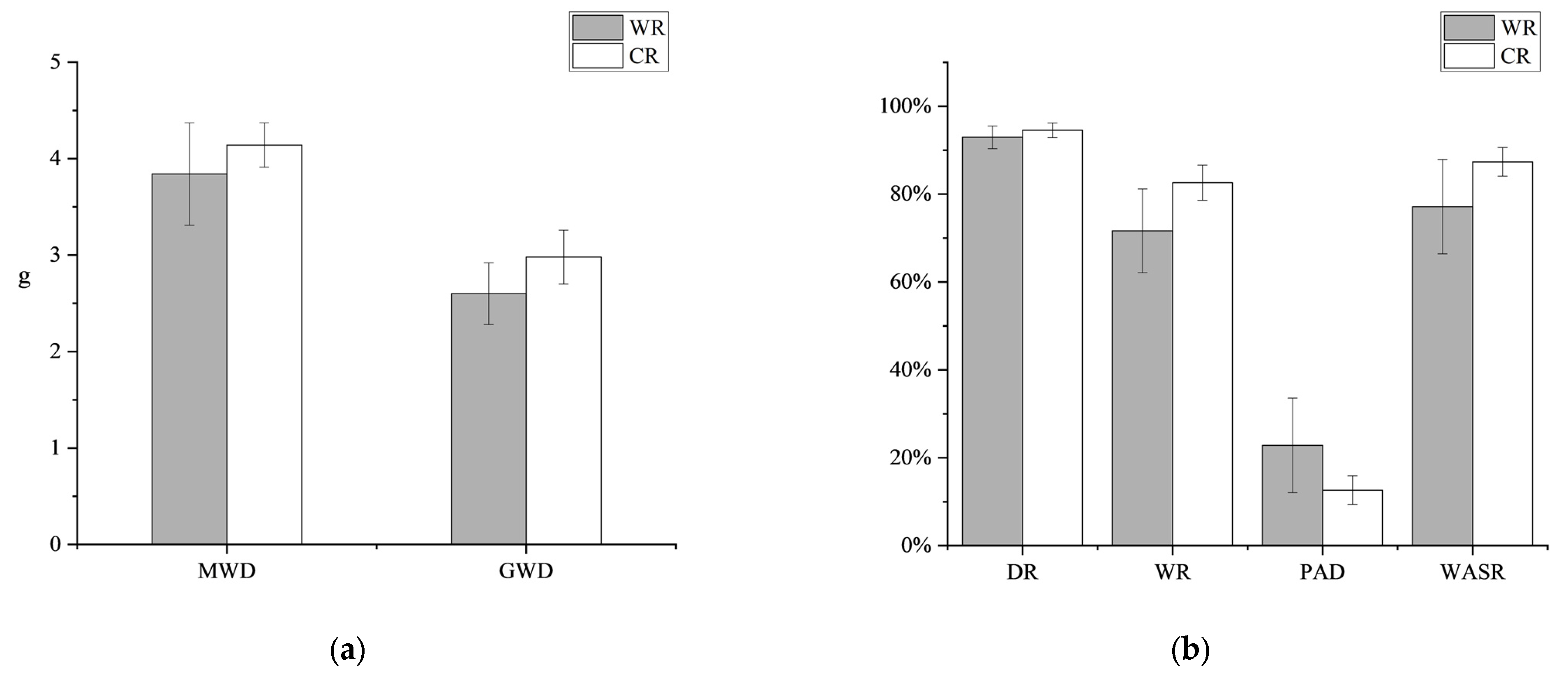
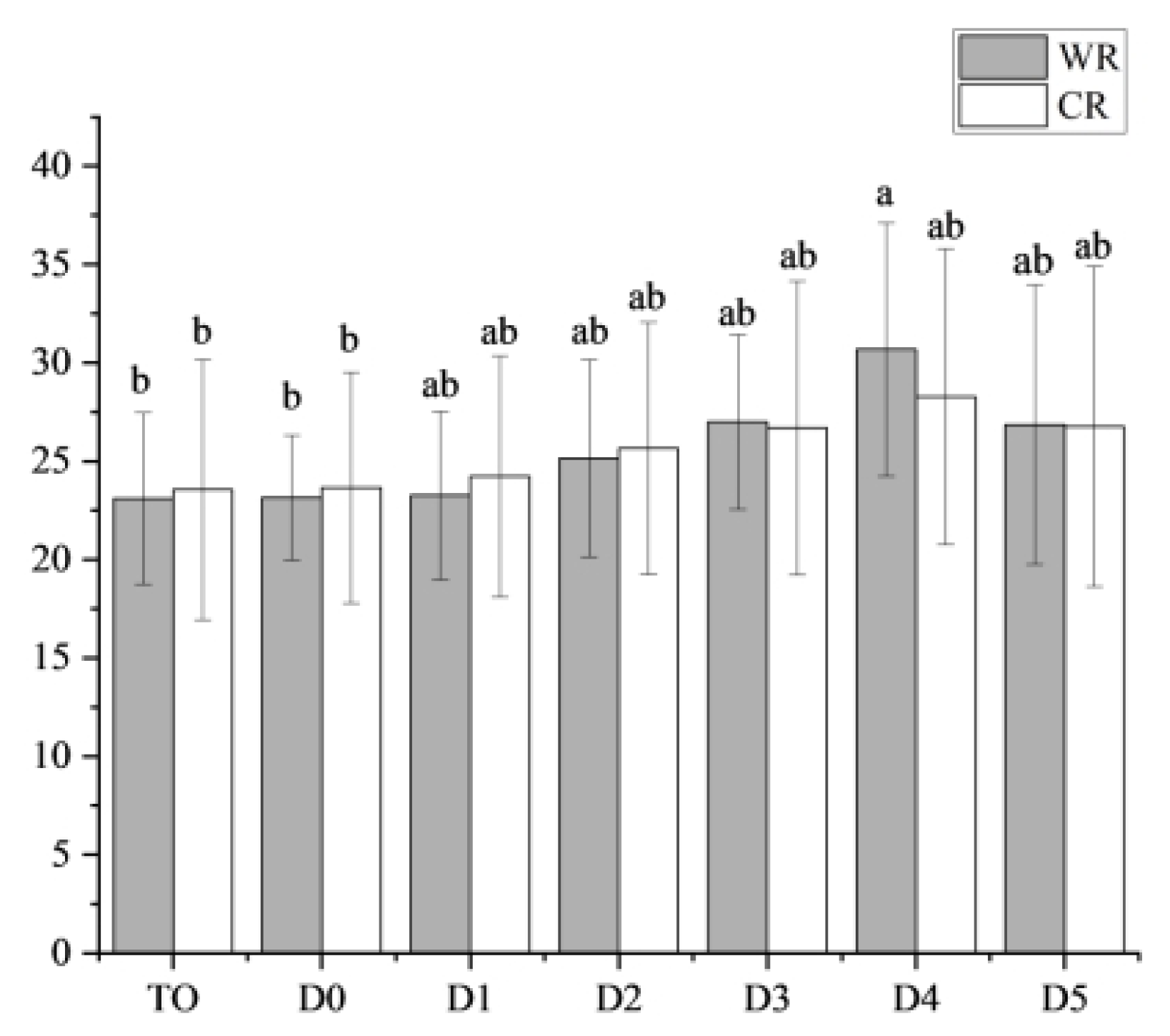
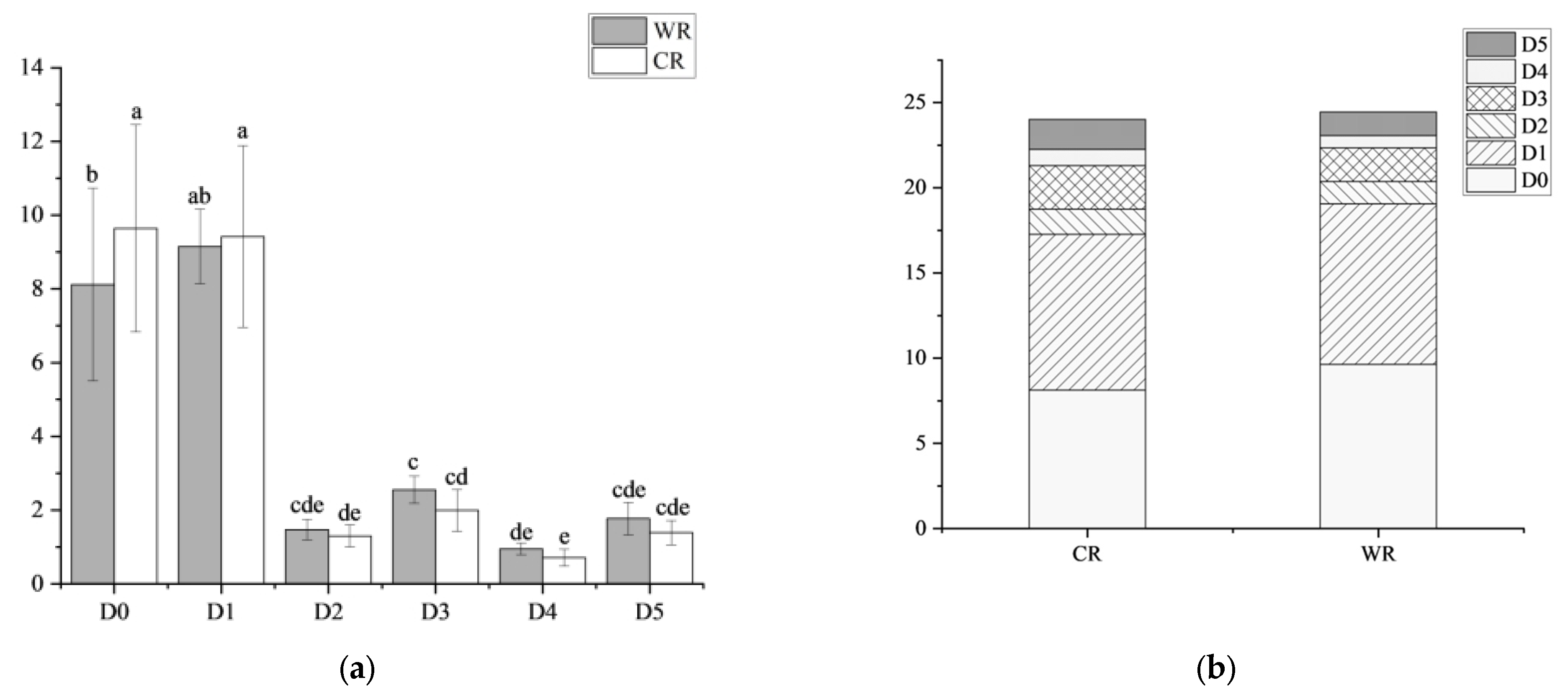
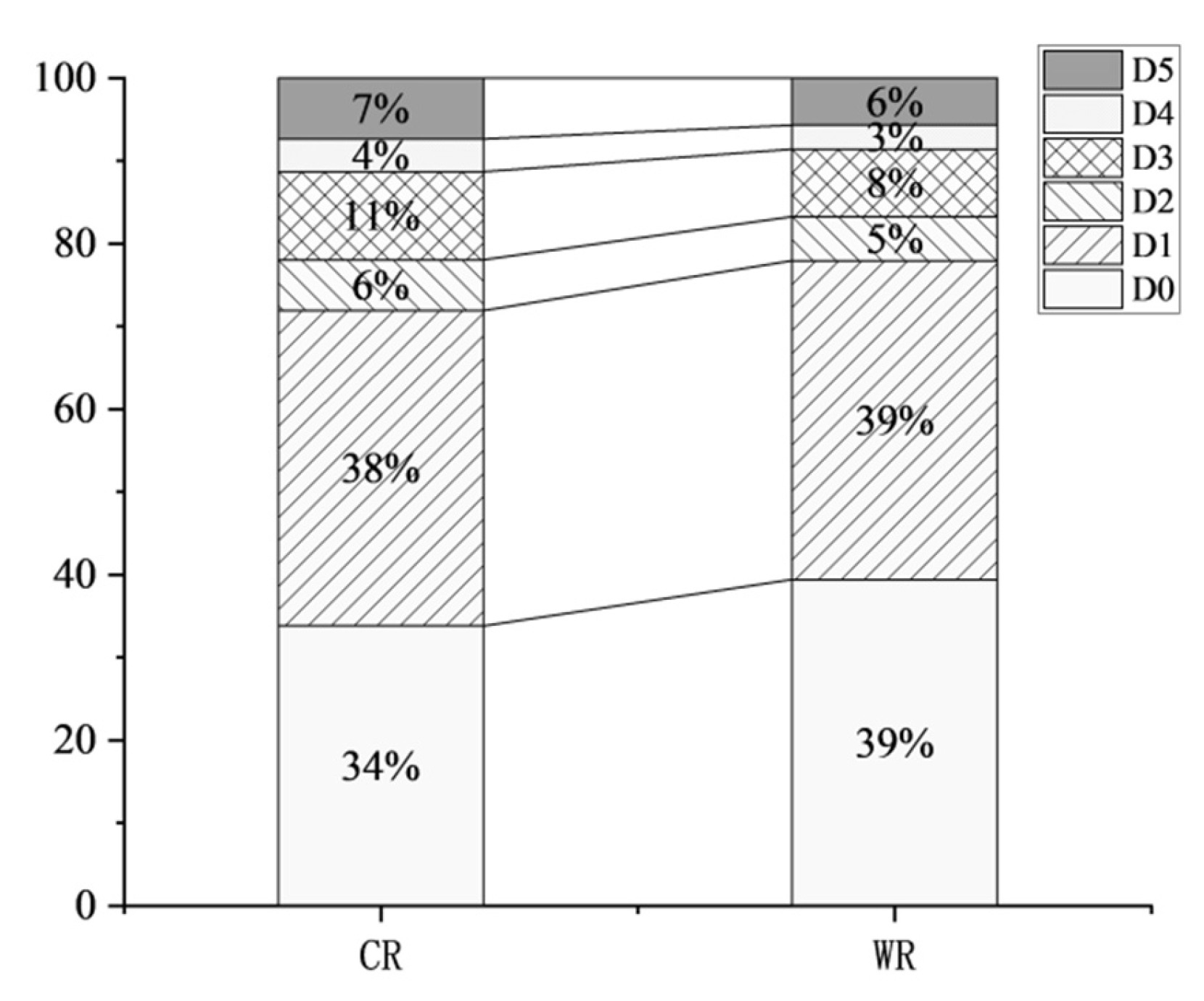
Disclaimer/Publisher’s Note: The statements, opinions and data contained in all publications are solely those of the individual author(s) and contributor(s) and not of MDPI and/or the editor(s). MDPI and/or the editor(s) disclaim responsibility for any injury to people or property resulting from any ideas, methods, instructions or products referred to in the content. |
© 2023 by the authors. Licensee MDPI, Basel, Switzerland. This article is an open access article distributed under the terms and conditions of the Creative Commons Attribution (CC BY) license (https://creativecommons.org/licenses/by/4.0/).
Share and Cite
Lv, T.; Wang, C.; Xu, Y.; Zhou, X.; Huang, F.; Yu, L. Impact of Integrated Rice-Crayfish Farming on Soil Aggregates and Organic Matter Distribution. Agronomy 2024, 14, 16. https://doi.org/10.3390/agronomy14010016
Lv T, Wang C, Xu Y, Zhou X, Huang F, Yu L. Impact of Integrated Rice-Crayfish Farming on Soil Aggregates and Organic Matter Distribution. Agronomy. 2024; 14(1):16. https://doi.org/10.3390/agronomy14010016
Chicago/Turabian StyleLv, Tianqi, Caiyun Wang, Yueling Xu, Xueyan Zhou, Fan Huang, and Lei Yu. 2024. "Impact of Integrated Rice-Crayfish Farming on Soil Aggregates and Organic Matter Distribution" Agronomy 14, no. 1: 16. https://doi.org/10.3390/agronomy14010016
APA StyleLv, T., Wang, C., Xu, Y., Zhou, X., Huang, F., & Yu, L. (2024). Impact of Integrated Rice-Crayfish Farming on Soil Aggregates and Organic Matter Distribution. Agronomy, 14(1), 16. https://doi.org/10.3390/agronomy14010016





